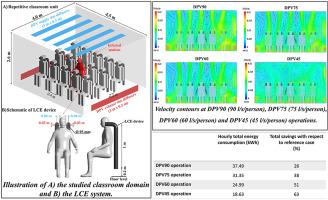Journal of Building Engineering ( IF 6.7 ) Pub Date : 2022-08-05 , DOI: 10.1016/j.jobe.2022.105066 Jennifer Karam , Elvire Katramiz , Kamel Ghali , Nesreen Ghaddar

|
This study proposes the integration of a localized - chair exhaust (LCE) device and a downward piston ventilation (DPV) in an educational space. The main aim is to assess the proposed system ability in providing a safe educational space similar to the case implementing the 2 m distancing between students at lower energy consumption. This allows the decrease of the DPV high supply flowrate without jeopardizing the protection level compared to the standalone DPV. A three-dimensional computational fluid dynamics (CFD) model of the educational space with DPV + LCE combination was developed as simulator software. The CFD model was validated experimentally and a parametric study was conducted to determine the best DPV supply airflow rate when assisted with LCE. The DPV flowrate should be capable of (i) preserving high protection levels, (ii) maintaining acceptable thermal comfort levels, while (iii) reducing the energy bill burden. Hence, an infected student was assumed sitting in the middle of the space and the exposure levels of the surrounding students were evaluated using the intake fraction (iF) index. It was found that for a practical use in educational spaces, the DPV system should be operated at 60 l/s per person with LCE at 20 l/s to maintain the high protection potential of the DPV system at 51% energy savings in the overall system energy consumption. Furthermore, the energy performance of the proposed system was compared to that of other ventilation systems implemented in educational spaces while offering same or better protection levels.
中文翻译:

向下活塞通风辅助局部座椅排气,以减轻教育空间中的病原体传播
本研究建议在教育空间中集成局部座椅排气 (LCE) 装置和向下活塞通风 (DPV)。主要目的是评估提议的系统在提供安全教育空间方面的能力,类似于在较低能耗下实现学生之间 2 m 距离的情况。与独立 DPV 相比,这允许 DPV 高供应流量的降低而不会危及保护水平。开发了具有DPV + LCE组合的教育空间的三维计算流体动力学(CFD)模型作为模拟器软件。CFD 模型经过实验验证,并进行了参数研究以确定在 LCE 辅助下的最佳 DPV 供应气流速率。DPV 流量应能够 (i) 保持高保护水平,(ii) 保持可接受的热舒适水平,同时 (iii) 减少能源费用负担。因此,假设一名受感染的学生坐在空间的中间,并使用摄入分数来评估周围学生的暴露水平(iF ) 指数。研究发现,对于教育空间的实际应用,DPV 系统应以每人 60 l/s 运行,LCE 为 20 l/s,以保持 DPV 系统的高保护潜力,总体节能 51%系统能耗。此外,将拟议系统的能源性能与教育空间中实施的其他通风系统的能源性能进行比较,同时提供相同或更好的保护水平。











































 京公网安备 11010802027423号
京公网安备 11010802027423号